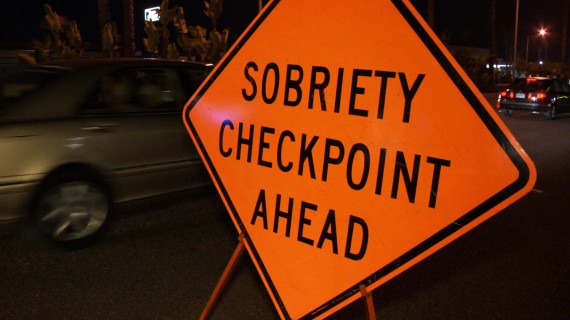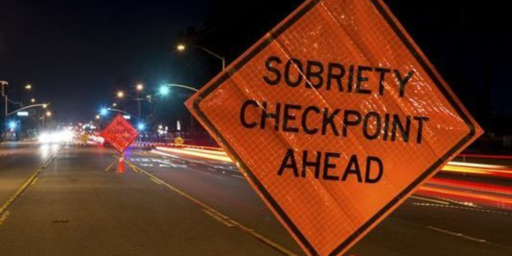States Resisting Calls To Lower DUI Blood Alcohol Levels
Back in May, the National Transportation Safety Board issued a report recommending that the blood alcohol volume limit for Driving Under the Influence (DUI) be lowered from 0.08 to 0.05. So far, states are resisting the recommendation:
The National Transportation Safety Board Chairman Deborah Hersman’s push to lower legal blood-alcohol limits for drivers appears headed down a dead end road.
States show little interest in revisiting the hot-button issue, industry groups are lining up against the plan and even the most ardent foes of intoxicated drivers
- including Mothers Against Drunk Driving (MADD) and the Governors Highway Safety Association (GHSA) – have declined to endorse it.(…)
“We don’t see any state going to .05,” said Jonathan Adkins, deputy executive director for the governor’s safety group. “This doesn’t seem to be getting any traction.”
GHSA, MADD and other groups have declined to take a formal position on the proposal, but have endorsed a range of anti-drunk driving measures including state laws that require breath-activated ignition interlocks for convicted offenders.
The groups’ campaign for that and other safety measures is predicated on enforcement of the .08 limit, and state-by-state consideration of more stringent blood alcohol levels could muddle the effort, the groups fear.
Without backing from the influential groups, states face less pressure to act. To date, none has taken up consideration of legislation in line with the NTSB recommendation.
Many state lawmakers recall the painstaking process of lowering the level to .08 from .10, which took more than two decades to accomplish nationwide.
State Rep. Terri Austin, an Indiana Democrat, said the federal argument to lower the limit would have to demonstrate clear, scientific evidence that the change is the best way to improve safety in order to convince the Hoosier State to act.
“I think legislators are going to want to have a pretty compelling case,” Austin said.
So don’t expect to see 0.05 anytime soon.






Lower isn’t necessarily better. At some point uniformity trumps artificially lowering the BAC to zero. On the other hand, I routinely travel to a place where the BAC limit is 0.00. And guess what: nobody drinks and drives, period, as best as I can tell, and most folks I know who travel there would agree.
My biggest concern with things like this is that I don’t trust the technology to be that reliably precise in measuring. I mean, I’m sure it’s _possible_, but is Randomville PD likely to use equipment that precise (and expensive)? Or are they going to use whatever gear they can lay their hands on, even if it can’t differentiate?
Agree with Uniformity as a goal – and let’s not stop with BAC! Being from the Western US, I was shocked last time I was in Texas at the number of drivers talking on their cell phones while they drive. The hodge-podge of vehicular safety laws creates confusion.
As to the topic at hand, philosophically I tend to resist cinching down standards in a futile attempt to guarantee perfect safety for all. .08% is itself constricted down from .10% of a few years ago and I think at some point there are diminishing societal benefit returns compared to the severe legal and civil penalties imposed for “drunk” driving.
Perhaps a middle ground in which the delta from .05% to .08% becomes a prescribed contributing factor when deciding civil awards for automobile crashes and other vehicular-imposed damage?
As a charter member of DDAMADD…I’m glad to hear this.
@C. Clavin:
So… the AA thing… didn’t work out too well for you, eh?
I think .08 is low enough. Hopefully before too long the driveless car arrives to make all this moot.
As a former Indiana resident (I’m a Purdue alum, so I don’t self-identify as a “Hoosier”, not even retroactively) the most shocking thing here was an Indiana politician looking for “clear, scientific evidence” of anything at all.
MADD won its PR war against drunk driving a long, long time ago. Before MADD, it was seen as a source of humor at worst. Now, though, they can’t just declare victory and hang it up; they need to keep the money coming and the group going.
@legion: That is a serious problem as the current equipment can have issues detecting the current legal limit. There are some severe flaws in some of the test devices that are used by police. Add on the tendency to not properly calibrate the device or ensure it’s proper calibration and you end up with all kinds of problems.
@Jenos Idanian #13:
From the article:
Even MADD wouldn’t endorse .05.
Generally, I’m open to the possibility that MADD has basically achieved its goals and is thus left flailing around for something to perpetuate itself. However, that doesn’t really fit here.
The vast majority of police departments use the National Highway Traffic Safety Administration’s DWI Detection and Standardized Field Sobriety Testing Student Manual when administering field sobriety tests. There are, however, multiple instructions regarding where and how a test should be given. So be it 0.8 or 0.5 – there is and always will be room for error.